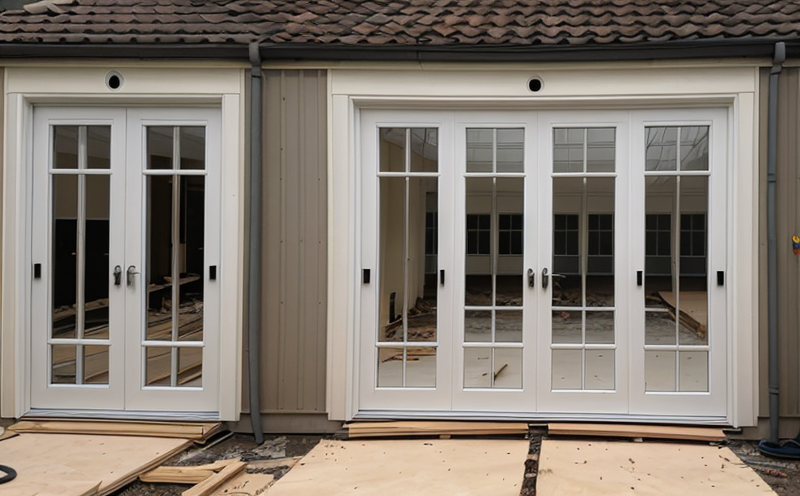EN 13501-2 Fire Classification of Doors
The European Standard EN 13501-2 is a critical document in fire safety testing, particularly focusing on the fire classification of doors. This standard specifies requirements for the design and construction of doors to ensure they can perform effectively during fires. Doors are evaluated based on their ability to resist heat transfer, prevent smoke from passing through them, and maintain structural integrity under various fire conditions.
The primary purpose of this testing is to ensure that buildings remain safe havens in case of emergencies. By meeting the requirements outlined in EN 13501-2, manufacturers can provide doors that not only meet regulatory standards but also contribute to a safer built environment. This service plays a crucial role in validating the performance of doors under fire conditions.
Testing according to this standard requires careful attention to detail. The process involves exposing the door specimens to controlled fire environments and measuring various parameters such as temperature rise, smoke release, and flame spread. Specimen preparation is critical; each door must be installed correctly before testing begins. This ensures that any observed failures or successes are due to the material properties of the door rather than installation issues.
The methodology for EN 13501-2 fire classification includes several key steps:
- Specimen preparation and installation
- Testing under controlled fire conditions
- Data collection on temperature, smoke release, and flame spread
- Evaluation of test results against the standard criteria
The acceptance criteria for EN 13501-2 are stringent. Doors must meet specific performance levels in terms of heat transfer resistance, smoke control, and structural integrity to be classified as compliant. These requirements ensure that doors can play a vital role in fire safety strategies.
Meeting these standards is not only important for compliance but also for enhancing the reputation of manufacturers who produce high-quality fire-resistant products. By offering this service, we assist businesses in ensuring their products meet stringent international standards and contribute to safer buildings.
Why It Matters
The fire classification of doors according to EN 13501-2 is crucial for several reasons. First, it ensures that doors can effectively perform their intended function during a fire. This includes preventing the spread of smoke and flames from one area of a building to another. Second, compliance with this standard can help avoid costly legal penalties and ensure businesses meet regulatory requirements.
Fire safety is a top priority in many industries, especially those where large numbers of people gather or work. By choosing doors that have undergone EN 13501-2 testing, organizations demonstrate their commitment to public safety. This not only builds trust with stakeholders but also helps safeguard against potential risks.
Moreover, meeting these standards can lead to increased marketability for products. Consumers and regulatory bodies are increasingly looking for evidence of compliance with international standards. By offering this service, we provide a competitive edge that can help businesses stand out in the marketplace.
Finally, ensuring fire safety through proper door selection and testing helps protect lives and property. In case of an emergency, doors that meet EN 13501-2 criteria can make all the difference in providing safe evacuation routes or containing a fire outbreak.
Scope and Methodology
The scope of EN 13501-2 is broad but specific, focusing on doors that are used as part of a building's fire safety strategy. This includes both standard doors and those with additional fire protection features such as intumescent coatings or self-closing mechanisms.
Testing according to this standard involves several key steps:
- Specimen Preparation: Doors must be prepared in accordance with the standard, which includes ensuring the correct installation of hardware and any special features like intumescents.
- Fire Exposure: Specimens are exposed to controlled fire conditions that simulate real-world scenarios. This allows for a realistic assessment of how doors perform under pressure.
- Data Collection: Various parameters such as temperature rise, smoke release, and flame spread are measured during the test. These data points are crucial in evaluating the performance of the door.
- Evaluation: The collected data is compared against the acceptance criteria specified in EN 13501-2 to determine compliance with the standard.
The methodology for testing ensures that doors undergo rigorous evaluation, providing confidence in their performance during a fire. This comprehensive approach helps manufacturers produce products that meet strict international standards and contribute to safer buildings.
Use Cases and Application Examples
- Hospitals: Ensuring that doors can withstand the extreme heat of fires is critical in hospitals, where patients need safe evacuation routes.
- Schools: Schools with large student populations require fire-resistant doors to protect students during emergencies.
- Offices: Fire-resistant doors help contain a fire outbreak and provide time for occupants to evacuate safely.
- Data Centers: The integrity of data centers is crucial, so fire-resistant doors are essential in preventing the spread of fire.
- Shopping Malls: Large shopping malls benefit from fire-resistant doors that help contain a fire and ensure safe evacuation routes for shoppers.
- Factories: Factories with process areas need fire-resistant doors to protect against the spread of fires that could affect production lines.
- Homes: Residential buildings can also benefit from fire-resistant doors, especially in multi-family dwellings where safety is paramount.
In each of these scenarios, EN 13501-2 testing ensures that the chosen doors meet the necessary performance criteria to protect lives and property during a fire.





